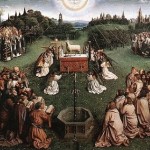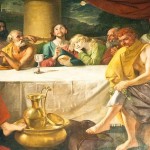 Brilliant and Provocative Book on Jesus and His Kingdom
Brilliant and Provocative Book on Jesus and His Kingdom
N.T. Wright’s latest book, “Simply Jesus,” claims to be a new vision of who Jesus is and what He did. Ultimately, the book is what it claims. It’s a sometimes brilliant and inspiring re-presentation of who Jesus is and what He came to do. But unfortunately, Wright doesn’t make this clear until the end of Chapter 11. A good summary of Wright’s major theme is this sentence from Chapter 11: “The gospels are not about ‘how Jesus turned out to be God.’ They are about how God became king on earth as in heaven.” Put another way: the Good News of Jesus Christ has to do with much more than people simply escaping earth for heaven.
Wright develops this theme throughout and does, indeed, offer a fresh and invigorating vision of Jesus Christ. But the book is marred by the fact that Wright’s best and most important ideas aren’t clear until so late in the book that they would be easy to miss. In fact, I would highly recommend reading Chapters 11, 13, 14, and 15 first so that the rest of the book may be more profitable! Because of the wonderful, challenging insights in the final few chapters, I give the book 4 stars, despite a very slow and not particularly refreshing beginning.
Chapter 1 is very slow going and doesn’t do much to present Jesus in a new light or help us to see Him any better. In Chapter 2, Wright presents 3 puzzles understanding Jesus represents: Jesus’ world is foreign to us; Jesus’ God is strange to us; and Jesus spoke and acted as if he was in charge. Chapter 2 wasn’t particularly insightful.
Chapter 3 discusses what Wright terms the distortions of skepticism and conservatism. He’s wrong, however, to put the two on the same level; one proceeds from faith and is an honest attempt to accept the Christ of the Gospels – the other isn’t. He presents the “conservative” view in such a way that it’s hard to find much fault with it, except that it does leave some important things out and has some misunderstandings. But this doesn’t, at least from the discussion in Chapter 3, merit the approbation Wright uses. Why, for example, is he so upset with the fact that both skepticism and conservatism ask the question: “Did it happen?” Wright himself has already spoken of how Christianity is a historical religion. He clearly has an ax to grind against “conservative” Christians, who believe things very close to what Wright believes. This unfortunately mars this work by Wright. Why would he, for example, call it “would be ‘Christian” conservatism” when discussing a view that takes the Bible seriously and Jesus as the historical God made flesh? Chapter 3 also deals with historical complexity; unfortunately, Wright raises the issue here but doesn’t shed much light on how to understand Jesus better until later in the book. I came to the book for a better picture of Jesus, not 3 chapters stating how our current views are inadequate.
Finally, in Chapter 4, Wright gets down to giving us some useful historical background to better understand the meaning of Jesus. He discusses, for example, the religious significance of Augustus Caesar and Jesus’ threat to the traditional religion of Rome. I do like the way that Wright contrasts the Roman “retrospective” eschatology that looked to the past to the Jewish “prospective” eschatology that looked to the future. It’s useful, as well, to see the 1st century Jewish situation as being set against an evil empire and a coming deliverer.
Chapter 5 is a chapter on God as King. There’s nothing remarkable, but it does set the tone for the rest of the book which develops the major theme of the Gospels that God has now come as King. Chapter 6 explores the key theme that God’s in charge now and is King. The chapter contains a useful, brief outline of Jewish history and a good treatment of the Exodus and 7 themes of the Exodus. Chapter 7 is generally useful as Wright presents God’s rule as manifested by forgiveness and healing. But, again, nothing particularly new or exciting.
Chapter 8 is a little more interesting as Wright discusses the importance of the stories that Jesus told. “They were stories designed to tease, to clothe the shocking and revolutionary message of God’s kingdom in garb that left the hearers wondering, trying to think it out, never quite able (until near the end) to pin Jesus down.” It’s useful to think of the parables as Wright does, that “They are saying: ‘Don’t be surprised, but this is what it looks like when God’s in charge.’”
Chapter 9 contrasts Christ as King with 2 failed Jewish kings – one before and one after Christ. It’s useful as history and to make a point about Jewish expectations, but it didn’t discuss Christ as King very much and therefore was not as helpful as it might have been. Chapter 10 is about battle the King will fight and how it’s not so easy to see who’s on which side of the battle.
By this point in the book I had resigned myself to having bought a book that wasn’t particularly worthwhile. It would have been tempting to give up and go on to something else. Am I glad I kept reading!
Chapter 11, on Space, Time, and Matter, struck me as particularly illuminating and represents the kind of fresh look I’d hoped to see all throughout the book. Here, Wright portrays theTempleas the nexus of Heaven and Earth. He continues by exploring the themes of how where God dwells was redefined by Jesus, how Time was fulfilled by Him, and how God has instituted a New Creation. These are especially rich and fruitful themes that should help many Christians see what the true meaning of Christ is in a new and deeper way.
Perhaps the most important paragraph of the whole book is tucked away at the end of Chapter 11: “First, it will not do to suppose that Jesus came to teach people ‘how to get to heaven.’ That view has been immensely popular in Western Christianity for many generations, but it simply won’t do. The whole point of Jesus’s public career was not to tell people that God was in heaven and that, at death, they could leave “earth” behind and go to be with him there. It was to tell them that God was now taking charge, right here on ‘earth.’” This thought lies behind Wright’s earlier objections to “conservatism.” It won’t do to think of the Gospels as being traditional proofs of God, Wright says, but instead we should see them as ones that would have made sense to 1st century Jews. We should see Jesus “as the reality to whichTemple, sabbath, and creation itself were pointing. That is, or ought to be, a clear indication that, in terms of the ‘God’ of first-century Jews, Jesus understood himself to be embodying this God, doing things whose best explanation was that this was what God was doing, and so on.”
In other words (and this is the very essence of what Wright is teaching): “The gospels are not about ‘how Jesus turned out to be God.’ They are about how God became king on earth as in heaven.” This is so important that I think Wright made a serious strategic mistake by not leading with these thoughts at the beginning. They are easily lost in much more mundane material.
Once again, I found Chapter 12 not all too illuminating. But Wright recovers his provocative and enlightening form in Chapter 13, where he frames Christ in terms of his uniting of the offices of prophet, priest, and king and his fulfillment of the Exodus story. Again, I wish there had been more of the material like Chapter 13. It’s in such writing that he’s at his best weaving together the complex imagery and narratives that culminate in Jesus Christ.
While Wright doesn’t dismiss other ways of viewing the meaning of Jesus’ death, such as an example of love, a representation of His people, and a penal understanding, Wright transcends these limited understandings. Ultimately, Wright thinks these other meanings are all united in the greater meaning that “Jesus’s death was seen by Jesus himself, and then by those who told and ultimately wrote his story, as the ultimate means by which God’s kingdom is established.”
I love the way that Wright, in Chapter 14, speaks of Easter as being the New Creation that demonstrates that “God’s kingdom is now launched, and launched in power and glory, on earth as in heaven.” He ties the Resurrection, as well, to Ascension and Enthronement, two aspects that are often tragically left out of traditional conservative theology.
Wright concludes in Chapter 15 with where I wish he had begun: by a brilliant presentation of how Jesus is already the Ruler of the World.
In the end, “Simply Jesus” lives up to its large claim to be a new look at Jesus and what He did. I heartily recommend it with the very important qualification that the best material is all in the last 5 chapters. You may want to read them first!
Wright presents his ideas in the following chapters:
Part One
Chapter 1 – A Very Odd Sort of King
Chapter 2 – The Three Puzzles
Chapter 3 – The Perfect Storm
Chapter 4 – The Making of a First-Century Storm
Chapter 5 – The Hurricane
Part Two
Chapter 6 – God’s in Charge Now
Chapter 7 – The Campaign Starts Here
Chapter 8 – Stories That Explain and a Message That Transforms
Chapter 9 – The Kingdom Present and Future
Chapter 10 -BattleandTemple
Chapter 11 – Space, Time, and Matter
Chapter 12 – At the Heart of the Storm
Chapter 13 – Why Did the Messiah Have to Die?
Chapter 14 – Under New Management: Easter and Beyond
Part Three
Chapter 15 – Jesus: The Ruler of the World











